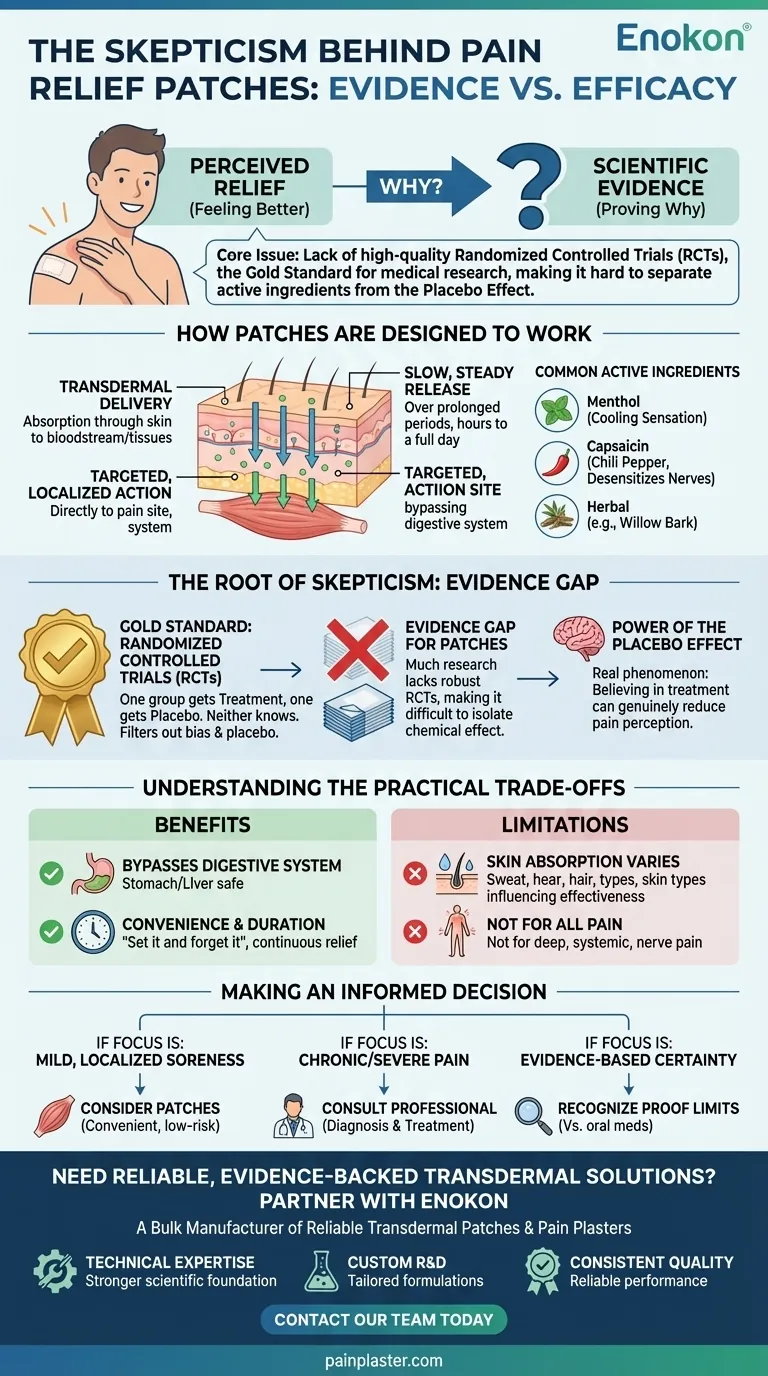The skepticism surrounding pain relief patches is not about whether people feel better after using them, but why. The core issue stems from a lack of high-quality scientific evidence, specifically a shortage of randomized controlled trials, which are the gold standard for medical research. This makes it difficult to definitively prove that the relief comes from the active ingredients rather than the powerful placebo effect.
While pain relief patches offer a compelling method for delivering targeted medication that bypasses the digestive system, skepticism is warranted. The primary concern is that their perceived effectiveness has not been consistently validated by the most rigorous type of scientific study, leaving open the question of how much of their effect is purely psychological.

How Pain Relief Patches Are Designed to Work
To understand the debate, it's essential to first grasp the intended mechanism of these products. Their design is based on a sound medical principle.
The Principle of Transdermal Delivery
Pain relief patches work via transdermal delivery, a method where active ingredients are absorbed through the skin to enter the bloodstream or affect local tissues.
This approach allows for a slow, steady release of medication over a prolonged period, ranging from several hours to a full day.
Targeted, Localized Action
Unlike oral pills that affect your entire system, a patch delivers its ingredients directly to the site of pain.
This localized action is a key benefit, as it aims to reduce pain in a specific area without causing widespread side effects.
Common Active Ingredients
The ingredients vary by product, but many over-the-counter patches rely on agents with well-understood properties.
Common examples include menthol, which creates a cooling sensation that can distract from pain, and capsaicin, the compound in chili peppers that can desensitize nerve receptors over time. Others use herbal ingredients like willow bark or turmeric.
The Root of Skepticism: Evidence vs. Efficacy
The theory behind the patches is logical, but the skepticism arises from the gap between plausible mechanism and verifiable proof. It centers on the quality of the evidence available.
The Gold Standard: Randomized Controlled Trials (RCTs)
In medicine, the most reliable way to prove a treatment works is through a randomized controlled trial (RCT). In an RCT, one group gets the real treatment while another gets a placebo (a fake treatment), and neither the participants nor the researchers know who got what.
This design is crucial for filtering out the placebo effect and other biases to see if the drug itself is actually working.
The Evidence Gap for Patches
Much of the research on commercially available pain relief patches does not meet this high standard.
Without robust RCTs, it is scientifically difficult to separate the chemical effect of the patch's ingredients from the psychological effect of doing something to treat the pain.
The Power of the Placebo Effect
The placebo effect is a real, documented phenomenon where a person's physical or mental health appears to improve after taking a placebo or "dummy" treatment.
The simple act of applying a patch to a sore muscle can send signals to the brain that help is on the way, which can genuinely reduce the perception of pain. Skepticism arises because, without RCTs, it's impossible to know how much of the relief is from the placebo effect versus the patch's active ingredients.
Understanding the Practical Trade-offs
Despite the questions about evidence, patches offer clear, practical advantages and have their own set of limitations.
Benefit: Bypassing the Digestive System
A major advantage of the transdermal route is that it avoids the stomach and liver.
This is especially beneficial for individuals who experience stomach irritation or other side effects from oral pain relievers like ibuprofen or naproxen.
Benefit: Convenience and Duration
Patches offer a "set it and forget it" convenience. They provide continuous, steady relief for many hours or even days, which can be more practical than remembering to take pills every few hours.
Limitation: Skin Absorption Varies
The effectiveness of a patch can be inconsistent. Factors like skin type, sweat, body hair, and the specific location of application can all influence how well the active ingredients are absorbed.
Limitation: Not for All Types of Pain
Patches are primarily designed for localized, superficial pain, such as a sore muscle or a single aching joint. They are generally not effective for deep, systemic, or nerve-related pain conditions.
Making an Informed Decision
Ultimately, the decision to use a pain relief patch depends on your goal, the type of pain you have, and your expectations for scientific certainty.
- If your primary focus is managing mild, localized muscle or joint soreness: Patches can be a convenient, low-risk tool worth trying due to their targeted nature and minimal systemic side effects.
- If your primary focus is treating a chronic, severe, or undiagnosed pain condition: You should consult a healthcare professional for a proper diagnosis and a treatment plan backed by stronger evidence.
- If your primary focus is evidence-based certainty: You should recognize that the proof for many over-the-counter patches is not as rigorous as for well-established oral medications.
Understanding both the practical benefits and the scientific limitations of pain relief patches empowers you to use them as an effective tool for the right situation.
Summary Table:
| Aspect | Key Takeaway |
|---|---|
| Mechanism | Delivers ingredients through the skin (transdermally) for localized, steady relief. |
| Core Skepticism | Shortage of high-quality Randomized Controlled Trials (RCTs) to prove efficacy beyond the placebo effect. |
| Primary Benefit | Bypasses the digestive system; convenient, long-lasting application for mild, localized pain. |
| Key Limitation | Effectiveness varies with skin type and is not suitable for deep or systemic pain conditions. |
Need Reliable, Evidence-Backed Transdermal Solutions?
As a healthcare distributor or brand, navigating the complexities of pain relief patch efficacy is challenging. You need a manufacturing partner committed to quality and scientific rigor.
Partner with Enokon, a bulk manufacturer of reliable transdermal patches and pain plasters. We combine advanced manufacturing with deep technical expertise to support your custom R&D and product development.
Benefit from our partnership:
- Technical Expertise: Leverage our knowledge to develop products with a stronger scientific foundation.
- Custom R&D: Collaborate on formulations tailored to your brand and target market's needs.
- Consistent Quality: Ensure reliable performance and patient satisfaction with every batch.
Let's develop effective pain management solutions together. Contact our team today to discuss your project.
Visual Guide

Related Products
- Far Infrared Deep Heat Relief Patches Medicated Pain Relief Patches
- Capsaicin Chili Medicated Pain Relief Patches
- Icy Hot Menthol Medicine Pain Relief Patch
- Menthol Gel Pain Relief Patch
- Far Infrared Heat Pain Relief Patches Transdermal Patches
People Also Ask
- How do Deep Heat Pain Relief Patches provide pain relief? Discover the Drug-Free Mechanism
- How does the Deep Heat Back Patch work? A Drug-Free Solution for Targeted Pain Relief
- What are pain relief patches and how are they used? A Guide to Safe, Targeted Relief
- How do pain relief patches provide targeted relief? Discover the Science Behind Effective Pain Management
- How do pain relief patches compare to other pain relief methods? Discover Targeted, Long-Lasting Relief
















